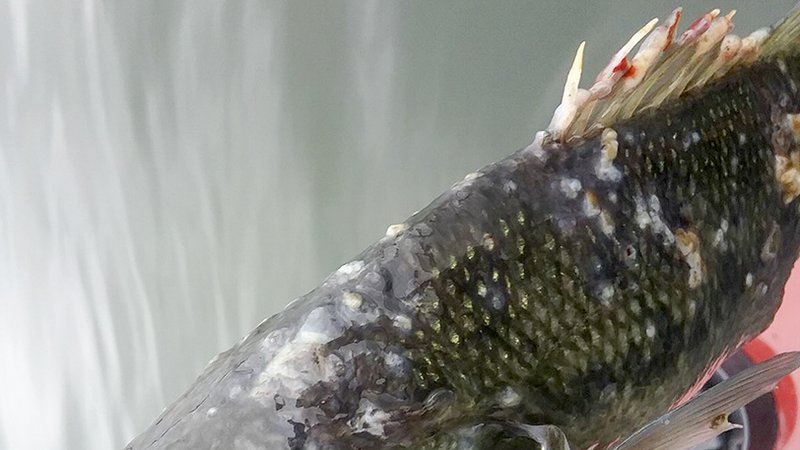Fungal infection on sport fish no cause for alarm
ON 11-25-2020

Nov. 25, 2020
Randy Zellers
Assistant Chief of Communications
As the weather cools, and many outdoors enthusiasts begin to put away their boats for winter, some are cashing in on the solitude and lower fishing pressure on their favorite lake. But as their catch rates increase, so do their chances of catching some fish that may be a bit unsightly. Many anglers send in photos to fisheries biologists and the Arkansas Game and Fish Commission’s Facebook page this time of year with bass or crappie that look like they’ve got a bad case of acne.
“It’s actually a fungal disease of fish and fish eggs called Saprolegniosis,” said Kelly Winningham, AGFC fish pathologist. “Some members of this fungi family are primary pathogens, but most are secondary pathogens and cause disease when there are other illnesses, injuries or stress.”
These types of fungus, also known as water molds, can affect any freshwater fish species, and are present in nearly all freshwater environments. They grow at water temperatures ranging from 32 to 95 degrees, but is most prevalent when water temperatures remain at or below 59 degrees.
“Saprolegnia in Arkansas typically occurs between October and March,” Winningham said. “This is generally when water temperatures are in the optimal growth range for the fungi. Unlike some diseases, water molds are everywhere in the environment. In the soil, in the water, everywhere. They are transmitted through the water and often get through the fish’s natural defenses when it is injured or stressed.”
Fish of any size or species can contract water molds. Although the outward appearance may differ. Scaled fish will exhibit fluffy white to brownish cotton-like patches on the skin, fins, gills or eyes. Non-scaled fish may have patches of dried skin that has lost color. Often, the fish will exhibit sunken eyes as the infection spreads.
In severe cases, where the majority of the skin and gills are covered with fungus, the fish eventually will die from the infection. In fish culture situations, such as catfish ponds, the disease can cause massive losses in fish. However, in wild populations, fungal infections such as water molds do not pose a large-scale threat and typically come and go as temperatures fluctuate.
Water molds pose no threat to people or pets. In small cases where only one or two spots occur on the fish, the area where water molds are present may be cut from fillets without cause for alarm if the angler chooses. In more extensive cases, the entire fish may need to be discarded. Anglers can help prevent some cases of water mold by handling fish gently and preventing abrasions and injuries to the fish’s slime coat while practicing catch and release, but the stress of being landed and the stress of temperature changes in the fall may be enough to cause the infection, despite the best efforts to protect the fish.
Recent News
Subscribe to Our Weekly Newsletter E-mails
Don’t miss another issue. Sign up now to receive the AGFC Wildlife Weekly Newsletter in your mailbox every Wednesday afternoon (Waterfowl Reports are published weekly during waterfowl season and periodically outside the season). Fishing Reports arrive on Thursdays. Fill in the following fields and hit submit. Thanks, and welcome!


